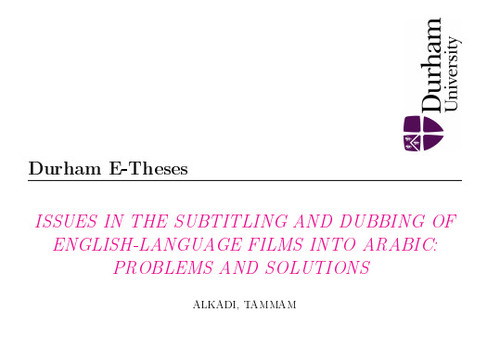“This study investigates the problems that translators tend to face in the subtitling and dubbing of English-language films and television programmes into Arabic and suggests solutions for these problems. In the light of an examination of the generic features of audiovisual translation and of the particular cultural constraints inherent in translation for Arabic-speaking audiences, it is proposed that certain elements of translation theory can be useful in overcoming the technical and cultural barr iers identified. This proposition is tested through analysis of the translation of three feature films, one television sitcom and an animation series that have been subtitled and dubbed into Arabic, with a particular focus on the translation of dialect, swear words, and humour. Technical, linguistic and cultural issues constitute a challenge to Arabic translators who need to deal with: 1) the limitations on screen such as space, time, lip and character synchronizations; 2) the issue of rendering English varieties into Modern Standard Arabic (MSA) and 3) the problem of culture which restricts them when they want to translate taboo expressions. This results in a loss (partial or complete) of the source film‘s message.
Each of the audiovisual works mentioned above was considered as a case study that was analysed using both qualitative and quantitative methods. Interviews, experiments and a questionnaire were conducted in this respect to find answers to the research questions. The interviews aimed to gather evide nce of how professionals translate, what problems they face, and what possible solutions they may suggest for them. The experiments and the questionnaire, on the other hand, were audience-focused tools in the sense that sample audiences watched and judged the ability of a translation both in subtitled and dubbed forms to deliver the message of a movie to them, and therefore, provided evidence on the relative effectiveness of different translation procedures. Based on this, solutions were both suggested and tested in terms of their viability to overcome the barriers that emerge during the subtitling and dubbing of dialect, swear words and humour into Arabic. The findings show that translators have significant scope for improving the quality of their output, especially by adopting a more functional translation approach that can help them successfully deal with the difficulties inherent in this type of translation and make the translated dialogue have a similar effect on the target audience as that which the source text has on its audience.”
PDF file, 246 pages
See on docs.google.com
